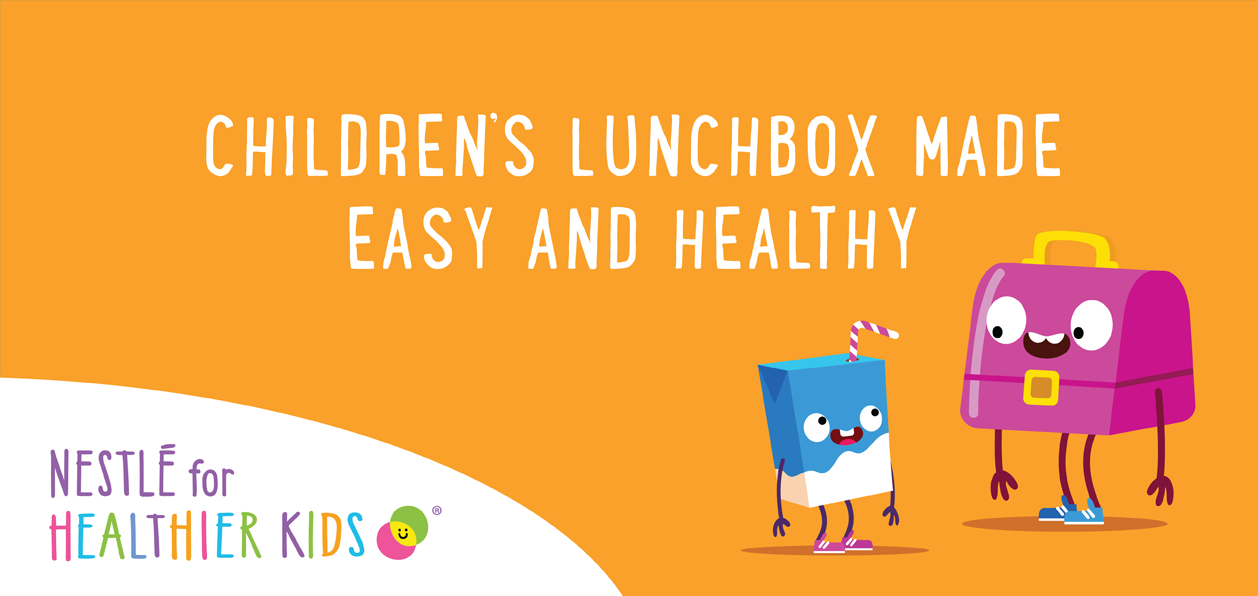YOUR CHILDREN’S LUNCHBOXES MADE EASY AND HEALTHY
Tips on how to add the goodness of fresh fruit and whole foods
A healthy lunchbox with the right foods is crucial for children to have energy to play, concentrate and learn all day. From around the age of three, children start being vocal about their food preferences. Unfortunately, what they want to eat is not always nutritious, which makes a healthy lunchbox a challenge for many caregivers. But there are a few tips and tricks that can elevate your children’s lunchboxes and make a meaningful difference to their present and future health.
Always include a fruit and/ or vegetables in your child’s lunchbox
Most of the salt and sugar children eat comes from processed foods. Including more fresh fruits and vegetables is a great way to lower salt and sugar intake naturally. Fruits are naturally low in sodium and have plenty of fibre and vitamins for good health. It is recommended to add a real whole fruit – like an apple and banana instead of fruit bars as they may contain added sugars. Alternatively, you can add a handful of dried fruit such as raisins, apricots, and prunes.
Before buying food for lunch boxes consider making your own special snacks.
When buying food for lunchboxes, caregivers ought to become food label savvy. Always read the label on the packaging to see the amount of sodium and added sugar contained in the product. Try to swap products with high sodium or sugar for products with low sodium or sugar. Snack foods like packets of crisps, sweet and savoury biscuits, sweet muffins and prepacked dips, cheese or processed meat and cracker packs can contribute to a lot of salt and or sugar. Swap these with low salt alternatives, such as savoury muffins, preferably homemade and even better have the kids help bake them. If you had meat the previous night consider keeping a bit aside for the lunchboxes the following day, instead of processed meats which can be high in salt.
Foods like cheese, wholewheat bread, vegetable sticks, fruit kebabs are all better options than the snacks kids buy at the local tuckshop.
Incorporating dairy products in the lunchbox is also important, but not always practical. Cheese is the easiest one to include the sandwiches or cubed for a quick finger snack. Yoghurt is a great source of calcium and use the plain variant and add your own fruits to it, that way you can also limit their sugar intake. Unflavoured milk is also a good choice, but make sure it is kept in a cool container to ensure it does not get sour during the day. Instead of fresh milk consider a powdered milk like NESTLÉ NESPRAY, that can last a bit longer before going sour. In addition, plain milk provides calcium, which is an important nutrient for bones and teeth.
For dairy-free options, consult with a registered dietitian to guide you on possible alternatives
Add water to your child’s lunchbox
Sugar sweetened drinks, like soft drinks, iced tea, sports drinks, cordial, energy drinks and fruit drinks are attractive to children but can contain up to 16 teaspoons of sugar in one serve.
Fruit juice is made from fruit, the juicing process means that most of the fibre is lost. It’s better to eat your fruit whole as it is more satisfying and contains more nutrients and fibre. If you choose to have fruit juice, have only a small serve, occasionally and consider diluting with ice or water. Try to avoid including juice poppers in the lunch box, save them for treats instead.
It is advised to serve your little ones with fresh water on a regular basis Water is very important to keep children well hydrated – make sure your child has a water bottle and that they consume regularly.
For more information on tips visit www.n4hk-esar.com
Ends.
Issued by Weber Shandwick on behalf of Nestlé East and Southern Africa Region
Contact: Tankiso Motsoeneng
Tel: +27 (0)61 374 7539
Email: tmotsoeneng@webershandwick.com
Media Queries Nestlé ESAR
Contact: Rosalie Ambrose Tel: 0795268518
Email: rosalie.ambrose@za.nestle.com
About Nestlé
Nestlé is the world’s largest food and beverage company. It is present in 187 countries around the world, and its 291,000 employees are committed to Nestlé’s purpose of unlocking the power of food to enhance quality for everyone, today and for generations to come. Nestlé offers a wide portfolio of products and services for people and their pets throughout their lives. Its more than 2,000 brands range from global icons like Nescafé or Nespresso to local favourites like Ricoffy*. Company performance is driven by its Nutrition, Health and Wellness strategy. Nestlé is based in the Swiss town of Vevey where it was founded more than 150 years ago.

